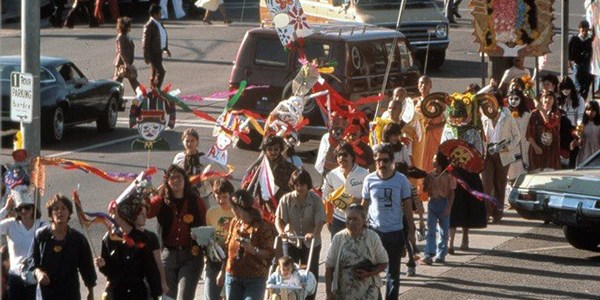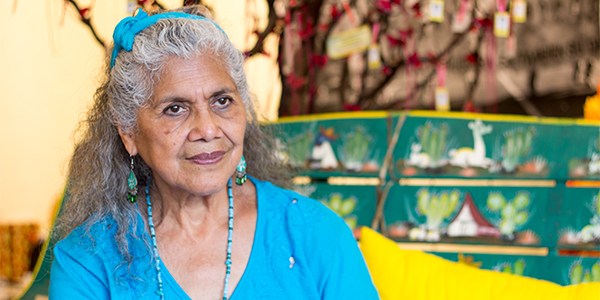For Ofelia Esparza, Día de los Muertos (Day of the Dead) is her busiest time of the year. The weeks leading up to Día de los Muertos are spent planning and creating altars at numerous locations are town. She’s gives presentations at college campuses on the meaning and history of this celebration. With Día de los Muertos growing in popularity every year, community leaders like Ofelia are essential in keeping the essence of this tradition alive and well. Her unwavering commitment can be seen in the altars she creates. As a retired educator and life long artist, she has no plans to stop anytime soon.
With the support of her family and the community of artists that she belongs to, Ofelia has been able to instill the true meaning of Día de los Muertos with countless individuals. For her, the meaning of Día de los Muertos is something that was instilled in her at an early age by her mother. Usually in coordination with the Catholic calendar, her mother had altars at home at various times of the year. They weren’t elaborate or large like the ones Ofelia makes today, they were small enough to fit on top of a dresser, table or shelf, emphasizing intimacy. They were adorned with flowers from the family garden, which included the traditional marigold, also known as the Cempasúchil.
Her mother never went into detail to explain why she placed certain items or did things a certain way because her practice of the tradition was rooted in an indigenous tradition – it was simply something that was done generation to generation. However, through Ofelia’s own research, experience, and learning from others who celebrate Día de los Muertos, she has been able to piece together the meaning and significance of items commonly found on altars. For example, the Cempasúchil attracts spirits through its bright color and distinct scent. In addition, calaveras (skulls) have been used since pre-Colombian times to represent the dead. Artists like Jose Guadalupe Posada, who used calaveras in his political cartoons and artwork, contributed in establishing the skull as part of the Día de los Muertos language of symbols and icons.
While the visuals of the tradition have changed over the years, the spirit of the celebration has not, which is to honor and remember ancestors and loved ones. In our lives, we go through what Ofelia explains, is three deaths. The first is the day we take our last breath. The second death is when we are buried, never to be seen again. The third, and the worst death anyone can go through, is when we are forgotten. “We’re only here for a short time and just like a flower that wilts or gold tarnishing, all things are temporary, but we live on in the memory and hearts of our ancestors because we are all here for a purpose.”
Los Angeles’ own Self Help Graphics & Art has been instrumental in growing the tradition of Día de los Muertos in the United States. Through happenstance, Ofelia’s beginnings at Self Help Graphics & Art date back to 1979 when a posted sign for instructors lead to her first meeting with founder Sister Karen Boccalero. In need of instructors for Día de los Muertos community workshops, Ofelia was hired on the spot after sharing her family’s history with the tradition. Since that day, Ofelia and her family has been a staple at workshops, but also in creating the community altar that has come to define Día de los Muertos at Self Help Graphics & Art.
Starting out as a participant in the building of the community altar and eventually leading the project, the altars themselves took a life of their own. Community residents would share their personal items and display personal pictures to honor their loved ones. With her families’ help, Ofelia also created themed altars in the downstairs space of the old Self Help Graphics & Art building called Galeria Otra Vez, which lead to the creation of Noche de Ofrenda, a Self Help Graphics & Art tradition that continues to this day, now in Grand Park. Noche de Ofrenda began in the mid-90s by Tomas Benitez, and the event was intended to host guest in the space to see the altars and art for that year’s celebration. Over time, the night transitioned into more of a community-oriented space for individuals to contribute to the community altar, but also for Ofelia to talk on the history of Día de los Muertos and its tradition.
Self Help Graphics & Art, along with Galería de la Raza in the Mission District of San Francisco, is one of the oldest institutions in the U.S. that have helped popularize Día de los Muertos. By continuing the tradition of bringing community together, these organizations are true to the spirit that inspired Sister Karen as she began building the tradition.. At the same time, she also involved community artist to participate and share their works on Día de los Muertos, a tradition that is continued to today, culminating in artist and community members coming together in celebrating the lives of loved ones.

Self Help Graphics & Art Day of the Dead circa 1970s. Photo by Self Help Graphics & Art.
As Día de los Muertos continues to grow and change, Ofelia is steadfast to remind individuals that Día de los Muertos isn’t just a “Mexican Halloween” celebration, despite the days being right after each other. “One shouldn’t consider Día de los Muertos a holiday because it devalues the tradition and meaning behind it.”

Ofelia Esparza. Photo by Javier Guillen
Ofelia encourages the curious to ask questions about Día de los Muertos and to not be afraid to inquire more about altars, or to contemplate and reflect on the idea of how our loved ones are remembered once they leave this world. “It’s not my job to say you can’t do this or you can’t do that. What I want to pass on is the tradition of remembering our loved ones, celebrating their lives, and keeping up their legacy for the next generation” says Ofelia, remembering what her mother used to tell her: “Ojala sigas con las tradiciones (I hope you carry on these traditions).”
-Guest blog by Erick Huerta, @ElRandomHero
See Ofelia’s Community Altar revealed at NOCHE DE OFRENDA on OCT 29, as part of GRAND PARK’S DOWNTOWN DÍA DE LOS MUERTOS. All altars will be on display thru NOV 6.


